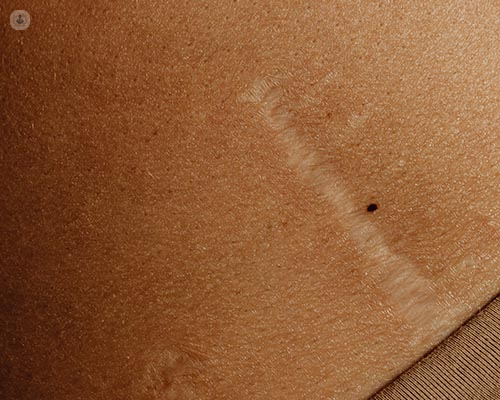Keloid scars: what are my treatment options?
Autore:Keloid scars can go deep into the skin, making people feel self-conscious and searching to find the best solution to improve their apperance.. Leading specialist in radiotherapy and non-cancer conditions Mr Richard Shaffer explains what they are and what the treatment options are available.
What are keloid scars?
Keloid scars are made up of tough, bulky scar tissue that extends beyond the area of the original skin injury. They form when scar tissue carries on growing rather than healing. They tend to start as raised, red and inflamed areas, later becoming a more normal skin colour as they settle down. Their appearance is the main issue for most people, but they can also be itchy or painful.

Are there any specific risk factors or conditions that make individuals more prone to developing keloid scars, and if so, what are they?
They are most common in dark-skinned people (in around 5-10%) compared with light-skinned people (less than 1%) and the average age when they appear is 10 - 30 years old. Sometimes other family members have had abnormal scars, and there may be a number of inherited genes that can cause them.
Are keloid scars preventable? What measures can be taken to reduce their likelihood of forming?
Keloids tend to form in response to damage to the skin, such as injury, surgery, acne, body piercing, tattoos, vaccinations (e.g. BCG) and insect bites.
Hormones can also play a part, such as sex hormones, for instance in polycystic ovary syndrome (PCOS) and thyroid hormone imbalances. High blood pressure can also be involved. Dealing with these factors may also help to stop these scars from growing.
Keloids often occur in areas where the skin is under tension, such as the chest and upper back. This indicates that certain heavy and repetitive physical activities may contribute towards their formation.
It is important to note that people who have previously had keloid scars should avoid unnecessary skin trauma, such as body piercing or tattoos.
What are the most effective methods for treating keloid scars? Can they be completely removed?
There are two main approaches to dealing with keloid scars:
- There are treatments that can improve the symptoms and size of the scar without removing it. For instance, steroid injections can be given to reduce the bulk of the scar. However, these injections do have side effects. They may cause the skin to change colour and unfortunately, 50% of scars will regrow after treatment. The effectiveness of steroids can be increased by using laser treatment before their application.
- The most definitive approach, particularly for large and troublesome scars, is surgical removal (excision) of the whole scar, followed by radiotherapy treatment shortly afterwards. Having surgery alone results in a high chance of the scar coming back (in around 80% of cases), therefore radiotherapy is used within 1-2 days after the surgery as it stops the scar from returning in the vast majority of cases.
If you require keloid scar treatment and would like to book a consultation with Mr Schaffer, simply visit his Top Doctors profile today.


